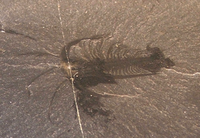
Dark stain
Encyclopedia

Fossils of the Burgess Shale
The fossils of the Burgess Shale, like the Burgess Shale itself, formed around in the Mid Cambrian period. They were discovered in Canada in 1886, and Charles Doolittle Walcott collected over 60,000 specimens in a series of field trips up from 1909 to 1924...
, representing decay fluids that were squashed out of the organism during the taphonomic process.
Occurrence
It is most famously known in (and most commonly associated with) Marrella, and is also known in other organisms: for example, AysheaiaAysheaia
Aysheaia was a genus of soft-bodied, caterpillar-shaped organisms average body length of 1–6 cm. The genus name commemorates a mountain peak named "Ayesha" due north of the Wapta Glacier. This peak was originally named Aysha in the 1904 maps of the region, and was re-named Ayesha after the heroine...
, where it protrudes from the anterior (and in one case posterior) end of the animal; Hallucigenia
Hallucigenia
Hallucigenia is an extinct genus of animal found as fossils in the Middle Cambrian-aged Burgess Shale formation of British Columbia, Canada, represented by the species H. sparsa, and in the Lower Cambrian Maotianshan shale of China, represented by the species H. fortis...
, Naraoia
Naraoia
Naraoia is a genus of trilobites found in Cambrian strata of the Burgess Shale and the Maotianshan shales Lagerstätte. They were flattened, oval-shaped animals, with an uncalcified shield that was divided into two regions, a smaller region covering the head, and a larger section covering the...
, and Alalcomeneaus. It is also present in other Lagerstätte
Lagerstätte
A Lagerstätte is a sedimentary deposit that exhibits extraordinary fossil richness or completeness.Palaeontologists distinguish two kinds....
n, for example in Carboniferous crustacea from Ireland.

